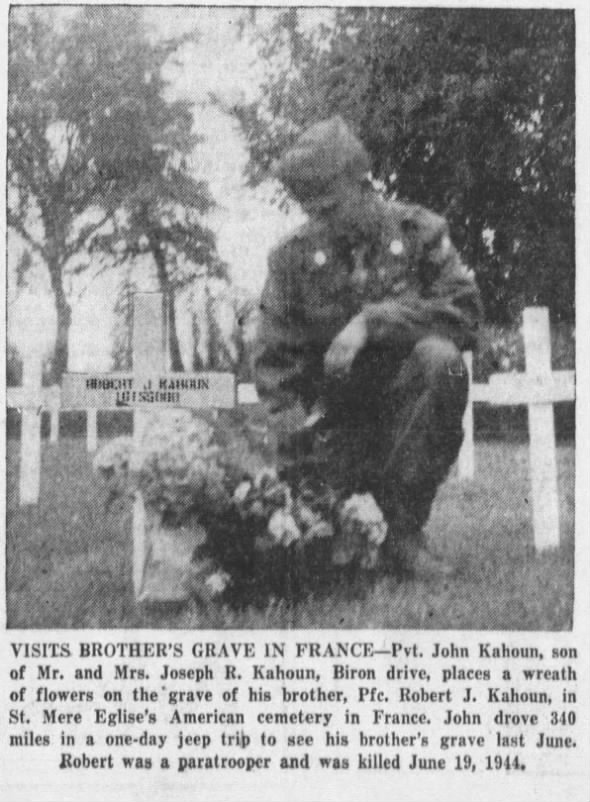 01 Aug 1945, Wed The Daily Tribune (Wisconsin Rapids, Wisconsin) Newspapers.com
The brutal harshness of the war brought a tragic end to a couple's vacation. Mr. and Mrs. Kahoun arrived home after a relaxing vacation, and they had received two letters in their absence. The first letter dated June 17th, and was from their son, Rob, who was stationed in France at the time. Rob wrote "I know how worried you must be, but don't worry, I'll be back before you know it." The second letter was a telegram from the war department. The telegram informed the Kahouns that their son, Paratrooper Robert J. Kahoun, had been killed in action on June 19th in France. 01 Aug 1945, Wed The Daily Tribune (Wisconsin Rapids, Wisconsin) Newspapers.com
The brutal harshness of the war brought a tragic end to a couple's vacation. Mr. and Mrs. Kahoun arrived home after a relaxing vacation, and they had received two letters in their absence. The first letter dated June 17th, and was from their son, Rob, who was stationed in France at the time. Rob wrote "I know how worried you must be, but don't worry, I'll be back before you know it." The second letter was a telegram from the war department. The telegram informed the Kahouns that their son, Paratrooper Robert J. Kahoun, had been killed in action on June 19th in France.
Robert J. Kahoun had been stationed in France, and was killed in action on June 19th, 1944, during the Invasion of Normandy. Normandy is an area on the coast of France, and south of the English Channel. The Allied forces began to invade this area on June 5th, 1944. This invasion is considered the battle that decided the outcome of the war in Western Europe. Before this invasion, the German Army was still occupying France and a few other countries, and the Nazi government still had access to Western Europe's raw materials and industries. Any resistance to the Nazi government was either disorganized or not very effective. Something had to be done. That something was Operation OVERLOAD, or, as we all know it by, the Invasion of Normandy.
The Invasion of Normandy began on June 6th, 1944, when the weather was predicted to have satisfactory conditions. The submarines, warships, and other vessels crossed the English Channel behind some minesweepers. They arrived on the beaches by dawn. One British and two American and divisions of paratroopers were dropped off inland. Six other divisions of soldiers stormed on to the beaches after a short bombardment by the ship's guns. At the end of the day, after some hard fighting, a foothold was established. The Germans attempts to fight back were disillusioned by the Allies, whose men and materiel was poured into France. By late July the Allies had reinforcements and constant combat, so a break was made from Normandy. Another landing in southern France had freed the nation from the Nazi government. The Allies were now pushing the Nazi German forces back into their homeland. After the victorious invasion of France, the Allied armies moved over to the offensive. Operation OVERLOAD was a physical blow to German military forces from which they would never recover from.
During the Invasion of Normandy, Robert J. Kahoun was a paratrooper in the 101st division, otherwise known as the "Screaming Eagles." The 101st division was one of the three Allied airborne divisions that were helping both attacks on water and on land. The 101st job was to secure the exits of the paved roads behind one of the beaches and destroy some of the bridges over Douve River and capture the two bridges north of the town Carentan. Division 101's role in the invasion involved its parachute component, which called for about sixty-six hundred men in three regiments to land in the dark and secure the three paved roads that lead inland from the beach. This was an important assignment, because the German forces had crowded in the low-lying areas behind the beach. The American paratroopers had a wild night. One survivor recalls that men landed "in pastures, plowed fields, grain fields, orchards, and hedgerows. They landed at the base of anti-glider poles, in tall trees and small trees. They landed on rooftops, in cemeteries, town squares, backyards, paved roads, and in roadside ditches. They landed in canals, rivers, bogs, and flooded areas." Division 101 then pushed on inland, until reaching the town of Carentan. There, they met up with the 2nd Armored Division, and successfully fought the German army and took the town. At the end of World War II, the division suffered, 1,766 killed in action, 6,388 wounded in action; and 324 died of wounds. For their efforts during World War II, the 101st Airborne Division was awarded four campaign streamers and two Presidential Unit Citations.
Robert J. Kahoun was a brave and terrific hero who was fighting for our country in a time of need. He was and will be very missed by all his loved ones.
We cherish, too, the poppy red
That grows on fields where valor led;
It seems to signal to the skies
That blood of heroes never dies,
But lends a luster to the red
Of the flower that blooms above the dead
Sources Cited:
http://www.history.navy.mil/photos/events/wwii-eur/normandy/normandy.htm
http://en.wikipedia.org/wiki/Battle_of_Normandy
http://www.history.army.mil/matrix/101/101-CC.htm
http://website.lineone.net/~nusquam/keepfait.htm
Rachael Devadas, Student
Marshfield Junior High
|